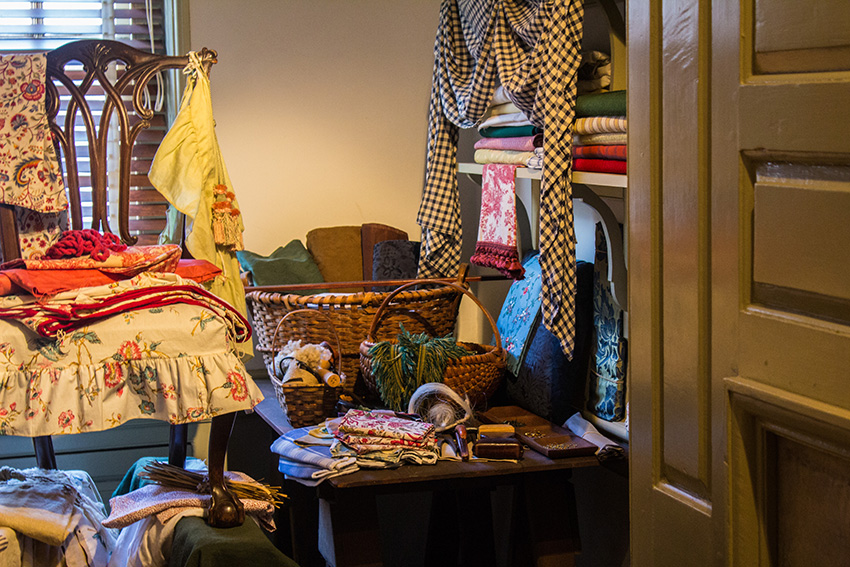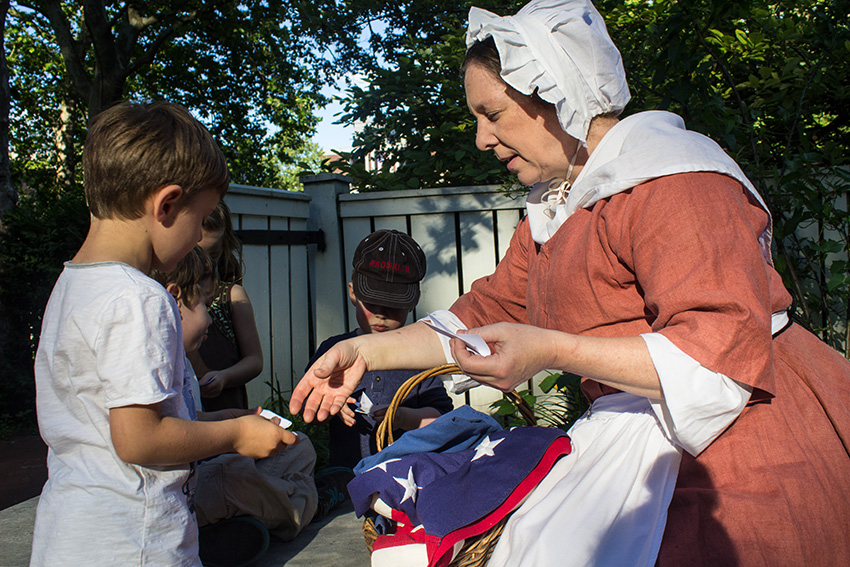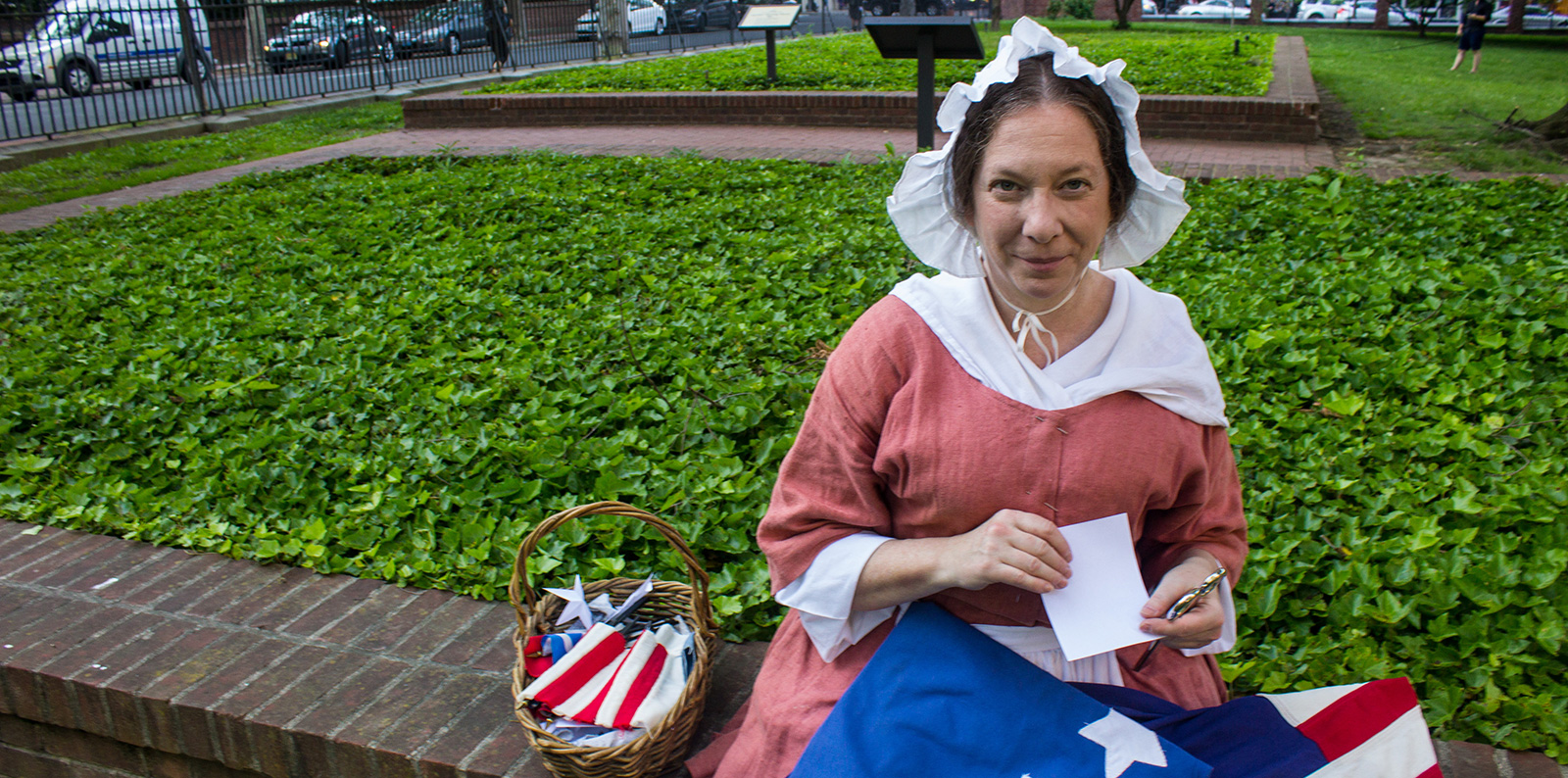Abigail Adams gets the cushier jobs. She attends the National Archives every Fourth of July, she went to the Democratic National Convention, and even stared into New Jersey Senator Cory Booker’s blue eyes as she delivered an inspirational speech at the New Jersey delegation breakfast. She’s also a little easier to portray, thanks to Adams’ well-documented life and well-preserved letters. In fact, she’s an “inspirational quote-box,” says Kim Hanley, a first-person interpreter with the American Historical Theatre (AHT).
In addition to playing Adams and nine other historical women, Hanley, 53, serves as the executive director of the AHT, a non-profit theatre with an extensive roster of first-person interpreters of America’s most notable figures, including Abraham Lincoln, Rosie the Riveter, and Mark Twain. Her interpreting jobs average about five to eight days a month, sometimes more, depending on the month (March, Women’s History Month, demands a gauntlet of wigs, frocks, and presentations). They take her around the country and to all kinds of events, including meet-and-greets, corporate events, and lineage organization events — such as luncheons hosted by the Daughters of the American Revolution.
At the AHT, Hanley has worked her way up the ranks (both administratively and theatrically), starting as an office assistant for the theatre’s founders, William and Pamela Sommerfield. She met William first, impressing him with her knowledge and understanding of history. William, in turn, introduced Hanley to his wife in 1998. At the time, Hanley was interpreting as Martha Washington with the hopes of becoming a museum educator, but Pamela Sommerfield thought she would fair better in another role. “She said I had no business being Martha Washington, but I’d make a lovely Abigail Adams,” Hanley says.
Looking back on her role as Martha Washington, Hanley agrees. “I was much thinner than I am now,” she says, noting a few differences in their physiques. Along with giving her office work, the Sommerfields put her to work as Abigail Adams, Hanley’s own personal heroine.

Today, Hanley’s interpretations extend beyond first ladies Abigail Adams and Martha Washington. She’s added many of America’s other most cherished women to her roster, including Annie Oakley, Lucretia Mott, and one of America’s more mysterious heroines — Betsy Ross.
Hanley says part of Ross’ allure in American history is her position as “an everyday hero,” thanks to her identity as a (rare) businesswoman. She describes her as the Rosie the Riveter of the Revolutionary War. “Martha Washington and Abigail Adams are the high figures,” Hanley says. “Betsy Ross is an every woman who everybody can look at and respect.”
Ross, one of America’s most beloved figures, is often introduced to children early, and as Ross, that’s who Hanley typically finds herself educating. As Ross, she travels to school programs across the country — like Florida, Texas, Indiana, and New York. June, in particular, is a popular month for her thanks to Flag Day, and Ross’s character gets booked for a wider variety of audiences. From June 10 to 14 this year, Hanley booked four Betsy Ross gigs, including a corporate meet-and-greet with the Wisconsin company Badger Meter and a general audience performance for a library in New Jersey. In the past, she’s also worked with her colleague Jason Raia’s organization, the Freedoms Foundation, a program at Valley Forge that uses historical interpreters to teach American history to visiting students and teachers.
Raia, who describes Hanley as extremely well knowledged in her subjects, is also the chairman of the board of the American Historical Theatre and has worked with her for many years. “Her whole point is she disappears into the character, and that’s really the key,” Raia says. “That’s based on her studies and her having really tried to get to know the characters that she plays.”
Today, on this late and sunny Thursday afternoon, she walks beside Carpenter’s Hall in full Betsy Ross attire, which includes a white cap over her own graying hair, an 18th-century, middle-class pink colonial gown, a white apron, a shawl known as a fichu, and an American flag. Three boys and a little girl on a stroll with their parents through Independence National Historical Park rush up to her. Hanley’s instinct to chat and engage the children kicks in, and she pulls out the paper and scissors from the weaved basket she carries as part of her costume. She begins teaching them how to create a five-pointed star with just a few folds and cuts of the white paper. As they work, she tells them the unfolded star will at one point look like Benjamin Franklin’s kite. She adds some other historical facts into the conversation, sharing that Ross has seven daughters and no boys. One boy, ironically named Benjamin, folds his paper and shouts, “Looks like a kite!” They finish, and as the children head off, Hanley stands and says goodbye to each of them by name.

Hanley, whose background includes eight years of production coordination in the New York garment industry and a degree in the restoration and history of decorative arts from the Fashion Institute of Technology, says the scrolls of American history include little provable information about Betsy Ross. There are no direct quotes taken from her letters or statements, and the one thing she’s known for, designing the first American flag, is often disputed. In fact, much of what we know about Betsy Ross was the result of a publicity push by Ross’ family during the country’s centennial celebration. “Her grandson pushed her out there as the woman who sewed the first flag, and from 1876 on, everybody started to believe Betsy Ross made the first flag for Congress,” Hanley says. “We have no idea if she made the first flag.”
To play Ross, Hanley needs to be a bit more creative (and selective) than she is with her other interpretations. When she’s Ross, she chooses her words carefully. “I would never tell anybody that I designed the flag, if I were being Betsy Ross,” she says. “I would say, ‘I have no idea if I am making the first flag because it was a secret.’” She also speaks with an Old English accent, though she admits there’s no way to know what Ross’ actual accent sounded like. Hanley relies on what she knows about Ross’ life to infer what her accent might have been. Ross grew up in Philadelphia, which, at the time, was the second largest city in the British empire. For Hanley, that means she likely spoke as the Brits did then.
Raia praises Hanley’s authenticity, and is impressed by her ability to commit to her character despite where her conversations — usually with people living in the 21st century — take her. “Regardless of what the question is, Kim will respond. She will come up with an answer that is rooted in Betsy Ross and in the time period, and she finds a way to communicate that,” Raia says. “It’s one thing to know a script, but when somebody throws a curveball at you in a question, to be able to stay in character and still respond appropriately is a real accomplishment.”
In order to prepare for her role as Ross, Hanley has studied sewing and the history of the flag, and has researched historical documents and techniques of the time such as how Betsy would have made certain items, like partridge boxes. Hanley also continues to read books about Ross. The latest is Betsy Ross and the Making of America by Marla Miller, which Hanley says does a great job of placing Ross in her surroundings. But it offers no new information about the woman behind the flag because physical evidence regarding the patriot is rare. Most of what is known about Ross is based on unreliable information provided through her family’s oral history.
What is known, however, is that designing the first American flag was quite a risk. Since it would have been created during the American Revolution with no sign of which way the war was going, it would have been considered a form of treason. If Ross did indeed design and create the flag, she did it alone: not in broad daylight, but at night after her shop closed, during her own personal time with her hands (just as the iconic image of Ross suggests), since no sewing machines existed at the time.
For Hanley, one detail she likes to emphasize about Ross is her identity as an entrepreneur. She ran a successful business as a seamstress, and Hanley believes her business acumen highlights an important idea. “Women were highly educated. If you educated a mind, that mind could run its own business,” Hanley says. “I think people forget to look at Betsy as a businessowner, as an entrepreneur, as someone who ran her own shop.” Even after the deaths of her three husbands, Betsy continued running her shop and maintaining her family. “She was successful, and she did raise seven daughters, and they all became useful members of their community,” Hanley says, before adding that two of Ross’ daughters died in infancy.

Ross was also an abolitionist and refused to hold any slaves. “She was a fair-minded businesswoman who employed people, who trained people to become upholsterers, who took on apprentices, and maintained a fair shop,” Hanley notes. “So she moves us also into a 19th century argument here in Philadelphia about abolition and the necessity for it.”
But even though the truth about Ross’s origins and legacy remain a mystery, she continues to earn a treasured spot in America’s history. Ross is not a Mary Young Pickersgill, whom history knows much about. Historical documents prove Pickersgill created the Star-Spangled Banner, the flag that served as inspiration for the famed poem by Francis Scott Key, upon which the national anthem is based. Yet it is ironic, Hanley says, that it’s Ross who the nation remembers.
Hanley knows her subject well and tries to portray Ross as accurately as possible, which sometimes leads her to obsess about even the smallest mistakes. Now, an hour after making stars with Benjamin and his siblings, she remembers that while talking to the children, she let the word “okay” slip into her conversation. Thinking back to the interaction, she frets about it, wishing she hadn’t made that “transgression,” letting a non-18th-century word sully her speech. “I have to be this person, and I can’t step out of that. I can’t step out of that into the 21st century,” she says.